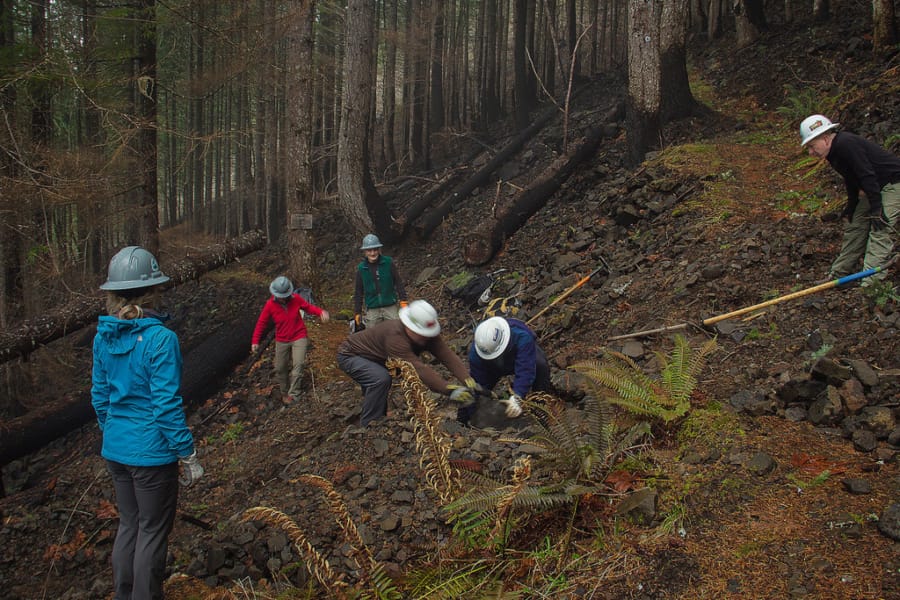Work crews are venturing into the areas burned by the Eagle Creek Fire and beginning the extensive work of assessing the damage done to the trails in the Columbia River Gorge National Scenic Area. These are the first recovery efforts aimed at reopening the popular hiking trails.
The fire was started on Sept. , 2017 by a 15-year old youth from Vancouver when he allegedly tossed an illegal smoke bomb into the tinder-dry forest. Extreme dry conditions caused the fire to explode, eventually covering approximately 50,000 acres.
While the fire caused extensive damage, in many places the damage was light with a mosaic pattern. While no timetables have been set for opening any of the trails, it does look as if some may reopen this summer.
U.S. Forest Service crews have teamed up with volunteers from the newly formed Gorge Trails Recovery Team and have cautiously started to assess the trails in areas that are stable enough to enter. Dangerous conditions exist in even the least damaged areas due to winter rains and the steep terrain of the Gorge.
The Gorge Trails Recovery Team is comprised of volunteers from the Pacific Crest Trails Association, the Washington Trails Association, Trailkeepers of Oregon, and the Friends of the Columbia Gorge. All the volunteers have received specialized training required for working in the dangerous conditions.
More than 20 miles of trails on National Forest system lands within the Eagle Creek Burned Area have been assessed, and volunteers have begun to help repair trails east of Cascade Locks. There are more than 120 miles of trails within the burned areas that need to be assessed and repaired.
Rachel Pawlitz, the public affairs officer for the National Scenic Area, said conditions within the closed burn area are extremely unstable.
“There were lots of rocks that were held (in place) for decades by moss and vegetation, but the fire released that safety net,” Pawlitz said. “There are standing dead trees that can fall at any time. The trails are in poor condition, and debris can come down behind you as you pass.”
Winter rains can add to the dangers by causing rockslides and landslides. Many of the most severely burned areas cannot be entered until the spring rains have come to an end.
Roberta Cobb, the chair of the Mount Hood chapter of the Pacific Crest Trail Association, has been involved with some of the volunteer work. She noted the wide range of burn severity within the closed area.
“We first did some work on the Pacific Crest Trail and that is totally fixable,” Cobb said. “Some of the other trails are pretty bad.”
Cobb reported that the Gorton Creek Trail and the Nick Eaton Ridge Loop had suffered significant damage.
“The Larch Mountain Trail was completely destroyed,” she adds. “The trail is covered by piles and piles of rocks.”
Not all the news has been bad. Crews have confirmed that the Upper Viewing Platform at Multnomah Falls survived the fire and is intact. However, other sections near the falls are in poor condition. The fence that has guarded the area from falling rocks and debris has filled with rocks.
That fence has partially given way and will need to be rebuilt.
The trails west of Multnomah Falls, currently in very poor condition, are a high priority for repair due to their popularity. Timelines for reopening west end trails remain uncertain at this time since they will need intensive repair and rebuilding.
Trails within the core area of the fire between Multnomah Falls and Herman Creek were the most severely burned and some trails may take several years to reopen.
When the trails do open, many hikers may find the extensive damage disheartening, but it is important to remember that forest fires are a natural process that will actually improve forest health in the long run.
Watching the forests recover over time may be a rewarding experience for hikers.
Closed areas: Public at risk
Given the extremely dangerous conditions existing in the closed areas, it is imperative that the public stay out until it is deemed safe to re-enter. Enforcement officials have already issued dozens of citations to people that have ignored the warnings and entered the closures.
In addition to risking injury or even death, as well as damaging resources, scofflaws also risk a chunky fine of up to $280.
Instead of trying to appease their curiosity, hikers would do well to remember that trails on the Washington side of the Gorge are still open. Hikers that hit these trails will discover that this side of the river has some serious gems to offer. Some of the best hikes include the Cape Horn Trail, the Dog Mountain trails, and the Augspurger Mountain trails.
Hikers are asked to consider that these trails, which are already popular, will undoubtedly receive a lot of extra attention this summer. The added impacts to the resources could be extensive unless hikers pay strict attention to the rules of the trails.
Also, hikers should try to car pool as much as possible to avoid over-filling parking areas.
As catastrophic as the Eagle Creek Fire was, the woods and mountains will recover. Once the trails do open it will be a good educational experience for those that venture in and see for themselves the way a forest heals.
Findings from each trail assessment to date can be found at the Columbia River Gorge National Scenic Area website.





